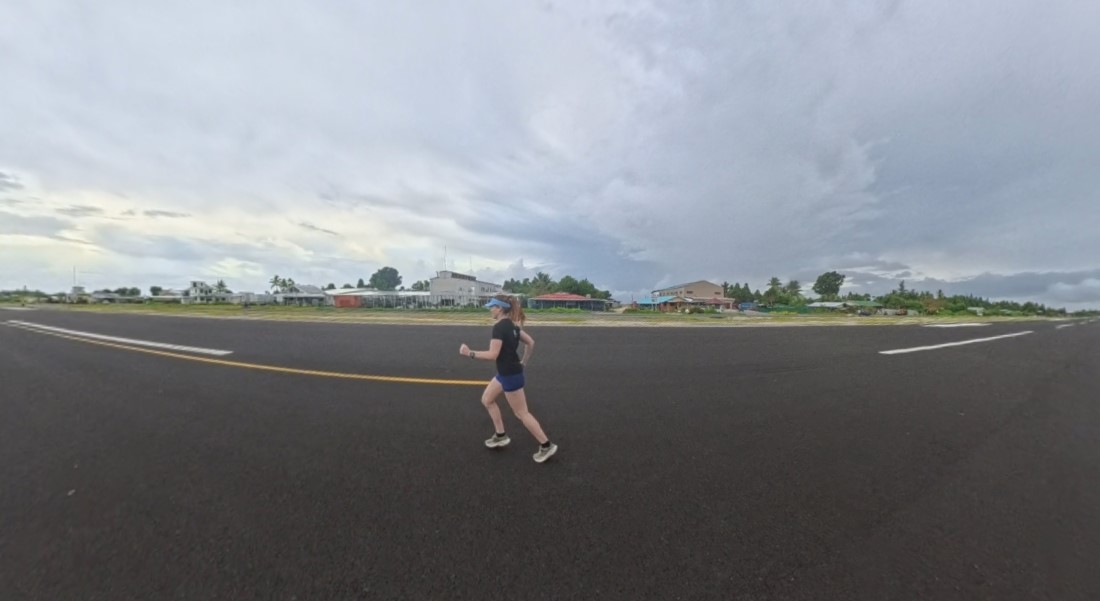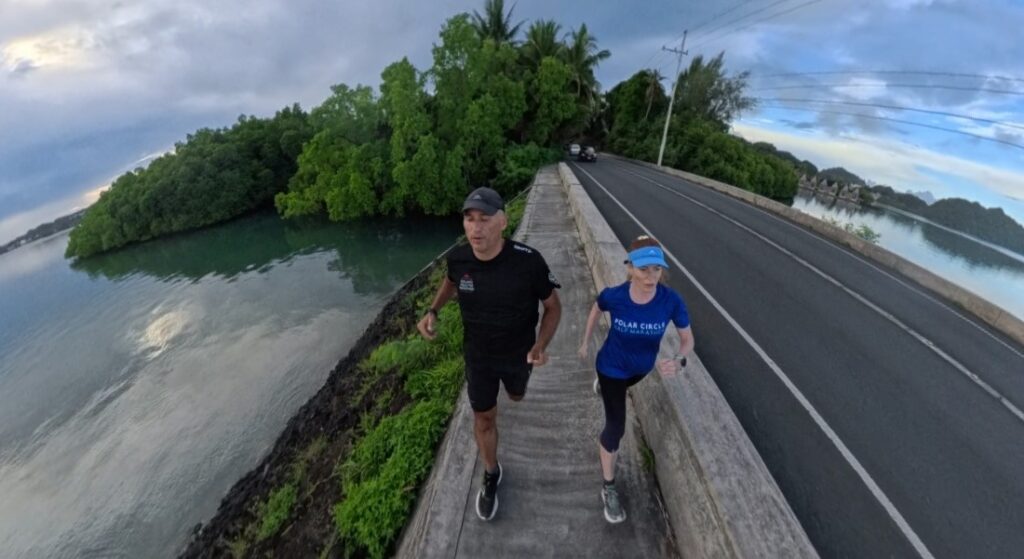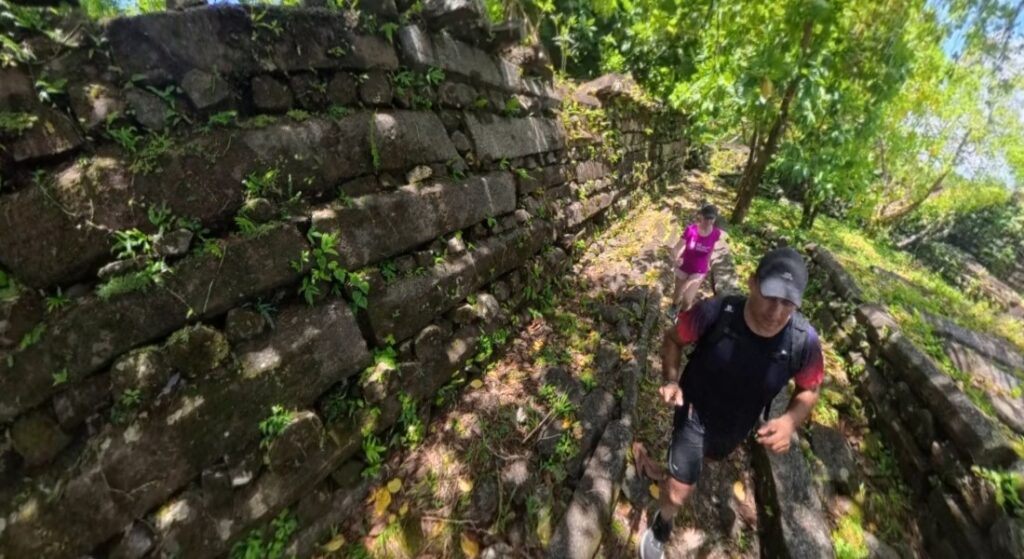Tuvalu, 2nd of September 2025.
Running through Tuvalu is like jogging on the edge of the world 🌊🏃♂️.
This tiny island nation, just 26 square kilometers of coral atolls scattered in the Pacific, is as remote as it gets. That isolation makes it a magnet for adventurous runners craving untouched beauty and zero crowds. It features first in the “least visited countries” in the World!
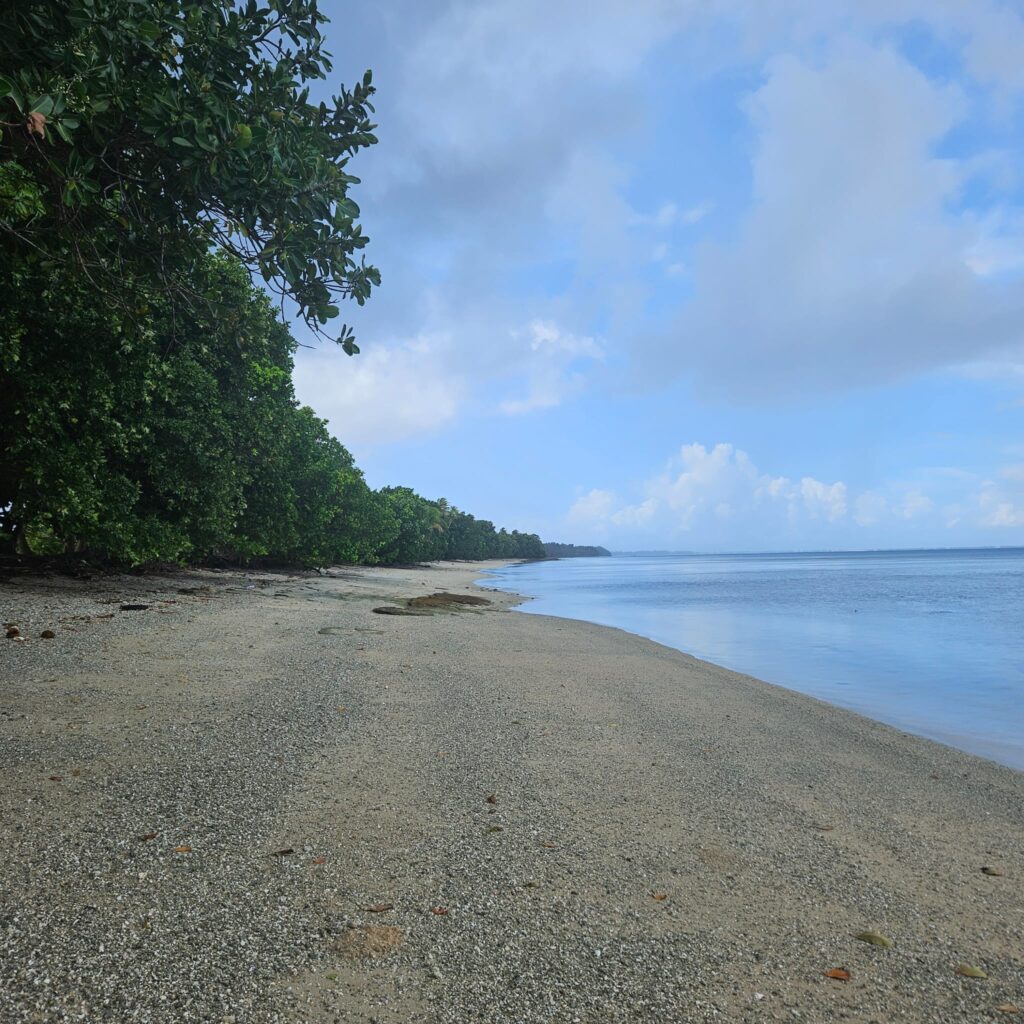
I never imagined that a journey to one of the least visited countries in the world would turn into such an adventure. From delayed flights and tiny airports to unexpected encounters with locals, every moment was unpredictable and exciting. Tuvalu isn’t just remote; it feels untouched, raw, and alive. The turquoise waters, narrow atolls, and scattered islands make every step outside feel like stepping into a hidden paradise.
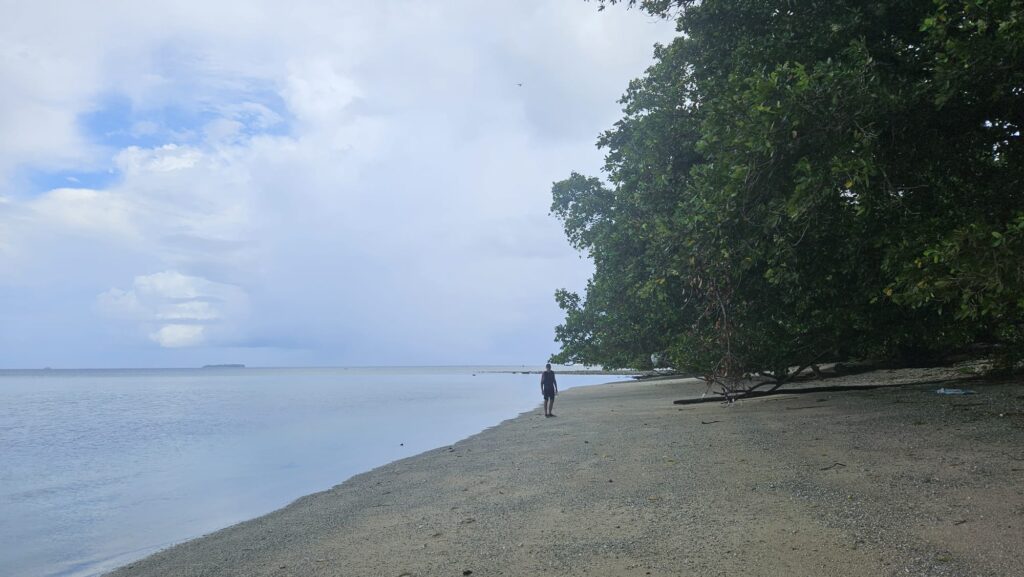
Running here was unlike anything I’ve experienced. The roads are lined with playful children, curious dogs, and surprising landmarks like tombs and the Prime Minister’s residence. We sprinted along rocky coasts, through makeshift trails, and even on the island’s runway, moments after a private jet landed. Every kilometer was a mix of thrill, laughter, and awe. Tuvalu’s landscapes and culture turned a simple run into a journey of discovery.
🌴 Why Tuvalu Should Be on Every Runner’s Bucket List
If you’re chasing a one-of-a-kind running adventure, Tuvalu’s unique blend of isolation and culture is unbeatable.
Kilometer after kilometer, you’re racing with nature… and dogs. But not against thousands of other tourists.
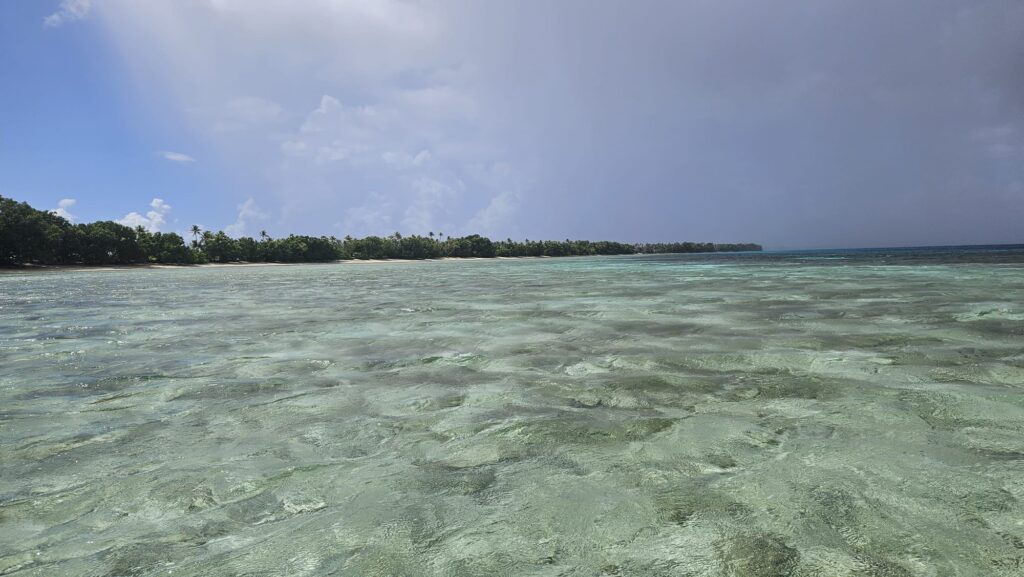
You’ll find villages where locals wave hello during your run, sharing stories or even joining you for a stretch. Combine that with sunsets that paint the sky in surreal colors and the fact that you can run barefoot on soft sand.
TLDR; “too long, didn’t read”
- I just want to run! Take me to RUN.
- I have 1 minute. Take me to USEFUL INFORMATION.
- Running is my excuse for travelling. Take me to TRIP.
- Running is my excuse for eating. Take me to CARBOLOADING.
- I want to know what to read in the plane. Take me to ONE BOOK.
- It’s a long haul flight! Take me to TO KNOW MORE.
🌍 The Trip 📷: What to see before or after running in Tuvalu
From a tourist’s perspective, Tuvalu serves up an under-the-radar experience: authentic island life, warm locals, and simple stays.
Runners can map loops along the narrow rings of land, weaving folklore and natural whispers into every stride. Post-run, the calm lagoons double as crystal clear recovery pools. No ticket needed! 🥥🔥
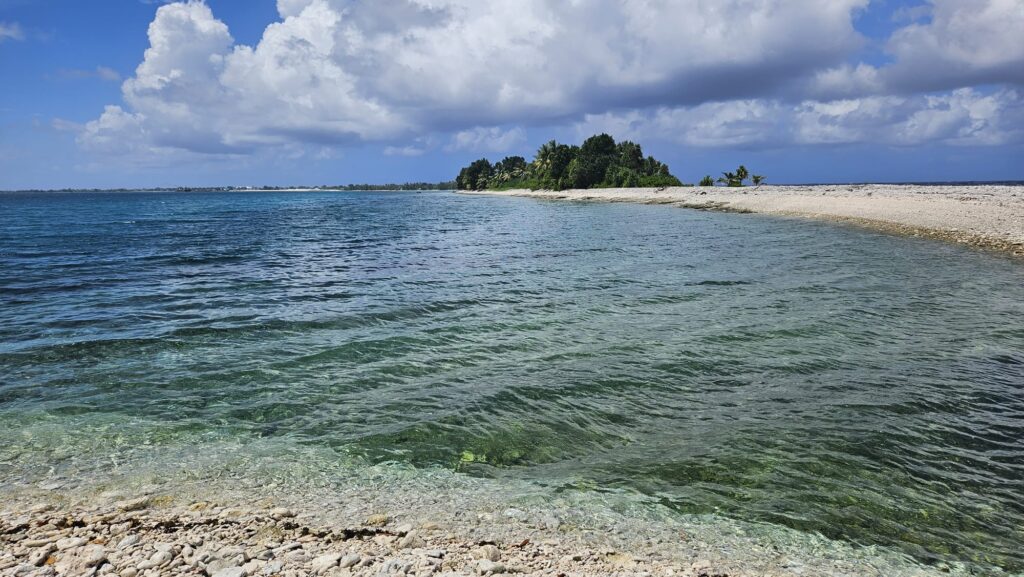
A Brief Story of Tuvalu
Tuvalu, formerly the Ellice Islands, gained independence from the UK in 1978. With fewer than 12,000 residents, it’s one of the world’s least populated nations.
Its story is rich in tradition: ancient navigation legends, community-based governance, and climate activism.
Curious fact: Tuvalu holds the Guinness World Record for “the country closest to disappearing,” barely rising more than two meters above sea level. It’s a living lesson on resilience, and why every visit matters—not just for your run, but for memory and meaning.
Fiji – Nadi and Suva
Our plane was delayed by an hour and a half. Panic set in over our connection to Suva 😅. Many on the flight were in the same boat. Hopefully, the plane would wait.
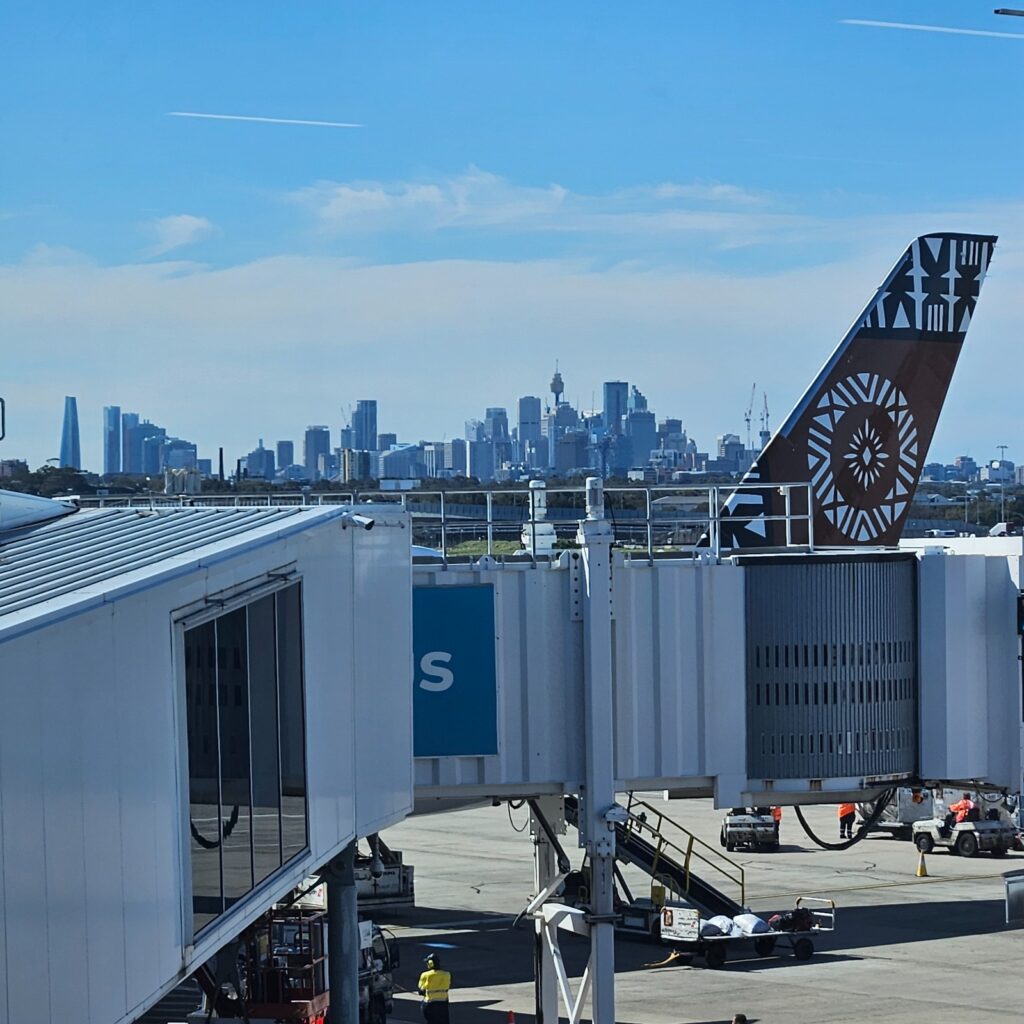
Onboard, Fiji Airways served a “Signature Mocktail.” It sounded fancy, but it tasted like soda. Loud kind-of elevator music played, themed around Fiji. “Oh Fiji, your sky is so blue…” 🎵
Landing in Nadi, we asked almost everyone in uniform about our next steps. Turns out, we had to go through immigration. The queue was long.
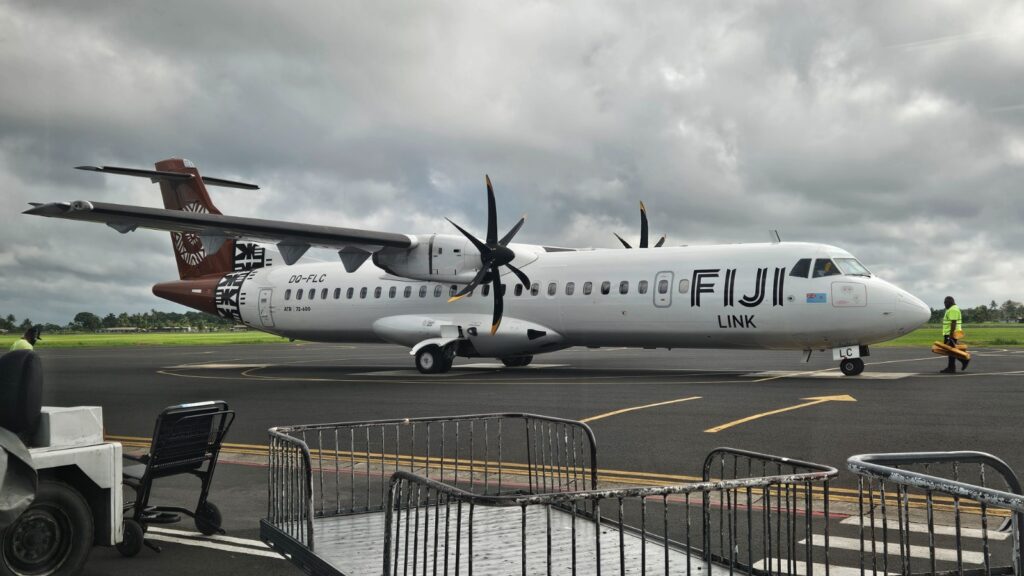
Finally, we cleared customs and rushed to the ground staff shouting “Suva! Suva!” They let us through security via a fast lane. Then we ran to the Domestic terminal. I kept muttering: “They are making me run the day after a marathon! Bloody hell!”
A hostess calmed us: “There are still plenty of people there.” We got our boarding passes and were allowed to carry our bags with us.
Passing through security was quick, though a Chinese family struggled with the process. They seemed stressed, poor souls.
Our old friend, the Alenia ATR 72
We reached our plane, a small Alenia ATR 72. It was our 13th flight. I joked: “We are going to die!” 😅 Inside, it was hot while waiting for the last passengers. At least they gave us water.
The flight was short and uneventful. In less than an hour, we arrived in Suva. We took off, received a glass of water, returned it, and landed.
Taxiing was smooth. Our luggage was with us. I had booked a cheap apartment close to the airport via Booking.com. Everything worked perfectly.
The taxi drove us to Mohans Apartments. It was a super short ride; the apartments were practically on the runway. We woke to the sounds of planes. You could see the runway right from the hotel!
The apartment was tiny but functional. Air conditioning, kettle, toaster. They called it an “apartment.” Water was technically potable, but we didn’t risk it. A shower, then bed. Seven hours of sleep was perfect! 😴
Tuvalu – Funafuti
At 6:30 a.m., another driver took us to the airport. He asked for payment 😅. We told him it was paid via Booking.
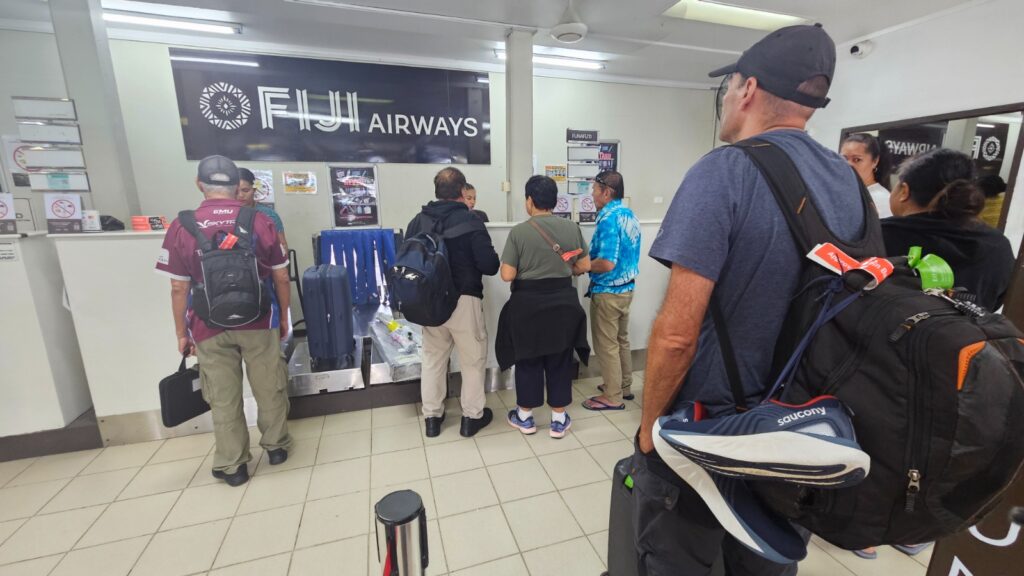
Check-in wasn’t open yet. Most passengers seemed Indian. We had 1 hour 30 minutes to spare.
Boarding was on time. Another Alenia ATR 72 awaited. From the window, tiny atolls appeared. White sand, turquoise water — pure paradise. We filled in the immigration form for Tuvalu: I saw again that its flag included the Union Jack, a nod to its colonial past.
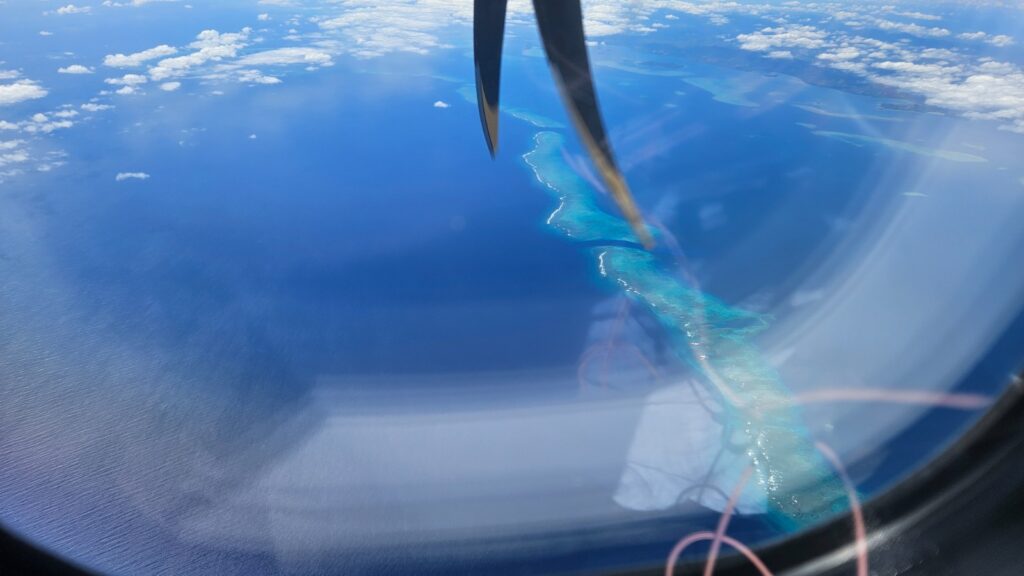
Aircon was blasting. We bundled up in jackets. Chinese tourists in the back were loud and rowdy, almost like a drunken group heading to Benidorm.
Landing was surreal. Roger didn’t understand the capital’s location. “But there’s nothing here,” he said. I laughed: “That’s the point!”
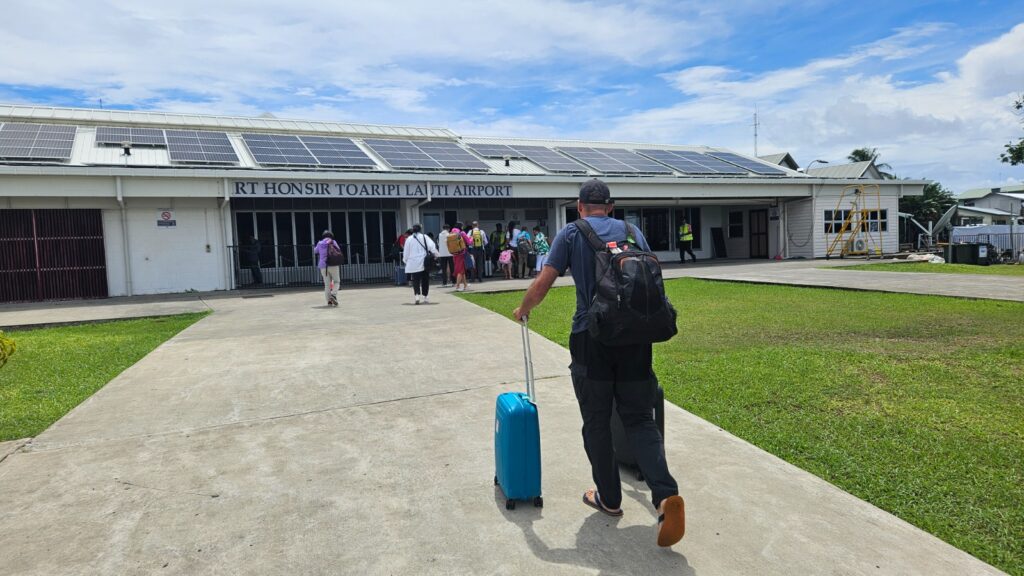
We are in the least visited country of the World!!
We passed immigration quickly. They asked if we visited Vanuatu, PNG, or Solomon Islands. Then customs asked about food; we showed our “Huesitos.”
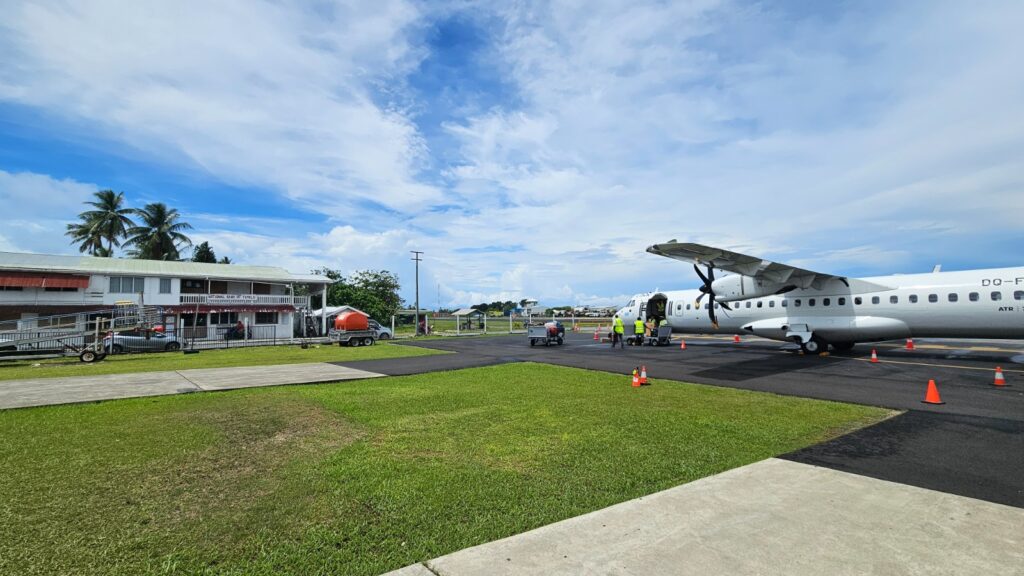
Outside, the street was sunny but pleasant. Parliament was open. I mistook it for a motel at first. The Prime Minister’s parking spot was visible.
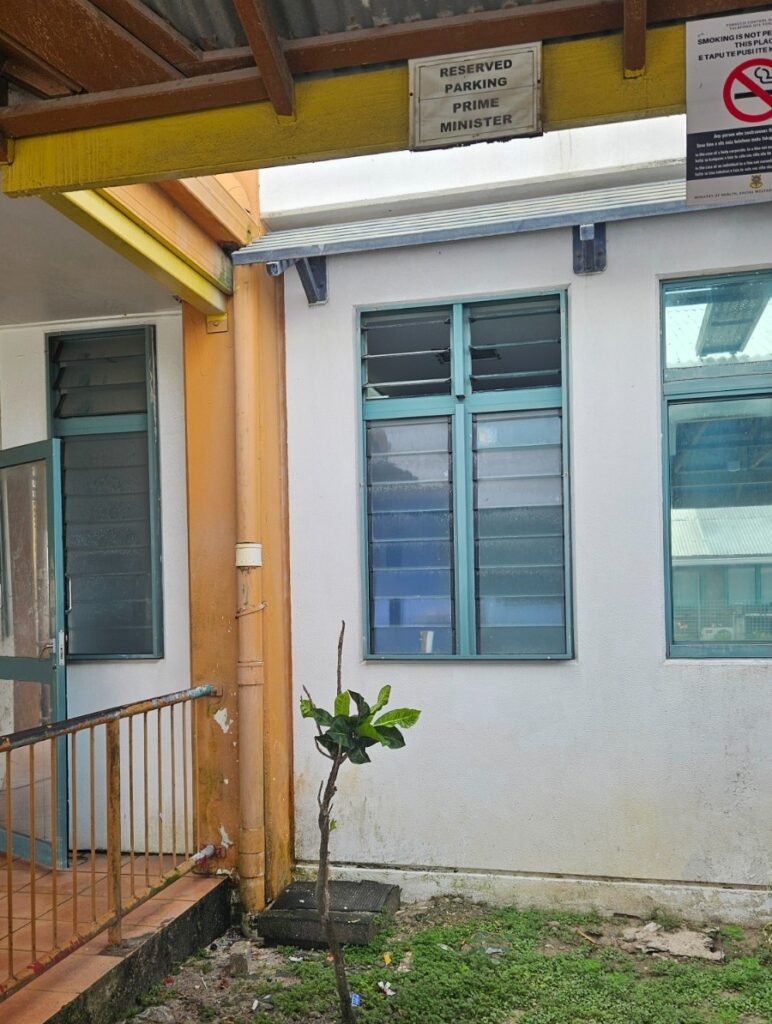
Locals were smaller than in Samoa. Many traveled by bike. Today was a Tuesday, so a Fiji connecting flight created anticipation. Funafuti Airport is tiny, served only by Fiji Airways. Flights are limited, and missing one can delay travel by days.
The airport itself is charming. When no flights arrive, the runway doubles as a playground. Locals gather there, reflecting the relaxed pace of life.
I spotted a paper sign at Filomena Hotel advertising “Fridge magnets.” Islanders chatted outside arrivals. Women sold jewelry temporarily after the Fiji flight arrived. Young men posed for photos near the airport sign. Two ATMs were broken.
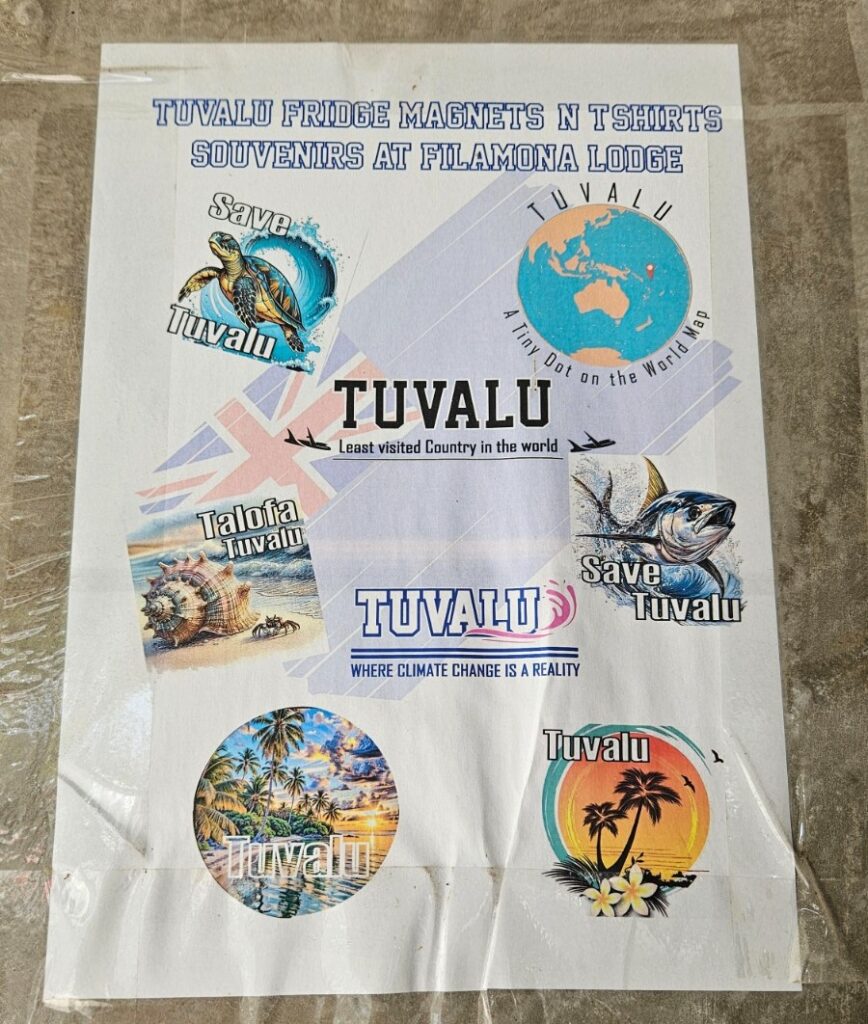
Our arranged pickup didn’t arrive. A kind local woman stepped in. Her friend drove us 25 minutes to NiuEti Lodge. She refused payment. The generosity was overwhelming compared to other countries.
The local pointed out well-kept houses, including the Prime Minister’s residence, “Tafola,” opposite the runway. Informal yet iconic.
Tuvalu Geography and Hazards 🌴
Tuvalu consists of nine islands: mostly atolls or reef islands. Atolls are coral rings with lagoons. Reef islands sit low on reefs. Funafuti is the capital atoll.
Fongafale is the main islet. Land is tiny, about 2.4 km², but Te Namo Lagoon is massive, 24 km by 18 km. Many islets dot the lagoon.
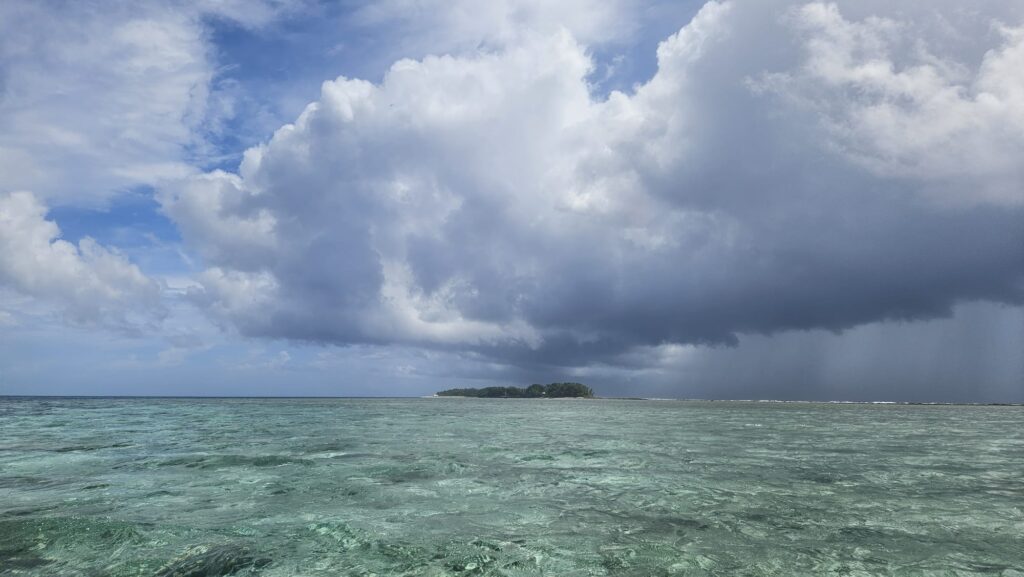
Vulnerability is high. Tropical cyclones sweep destructive winds and rains. King tides flood islands. Sea-level rise erodes land and contaminates freshwater. ENSO cycles bring droughts or cyclones.
Life in Tuvalu
The first days were a mix of wonder and adjustment. Airplanes, local ceremonies, and the raw beauty of a remote island made every moment magical.
We learned history: independence in 1978, separation from Gilbert Islands in 1974, retaining the British monarch as head of state. 👑
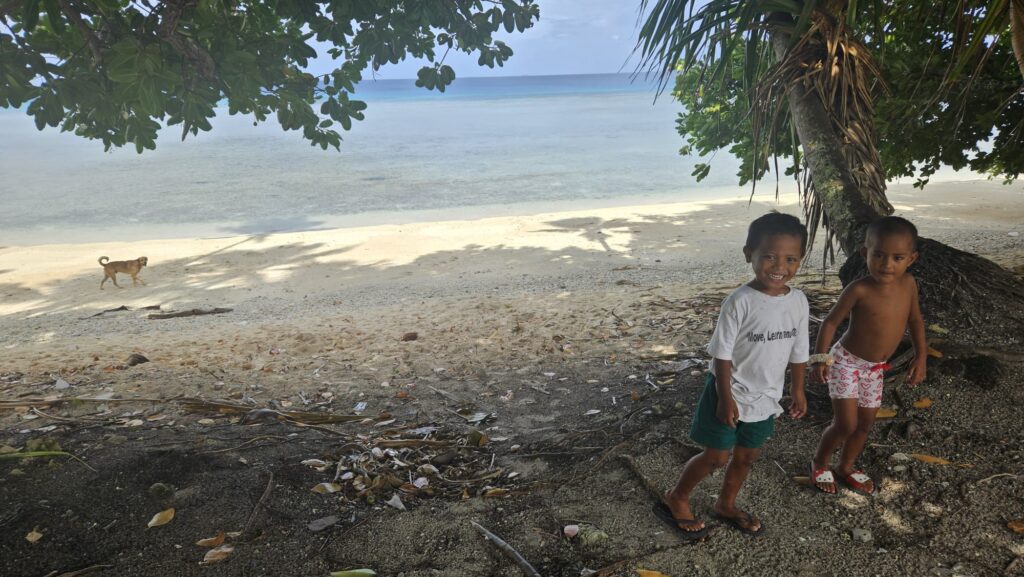
Queen Elizabeth visited in 1982, Prince William and Kate in 2012. Canoe ceremonies, dancing, and cultural performances marked their arrivals.
Locals were polite, curious, and helpful. Streets were functional, often untidy, with vibrant life visible everywhere. Dogs, tombs, and practical homes formed the rhythm of the atoll.
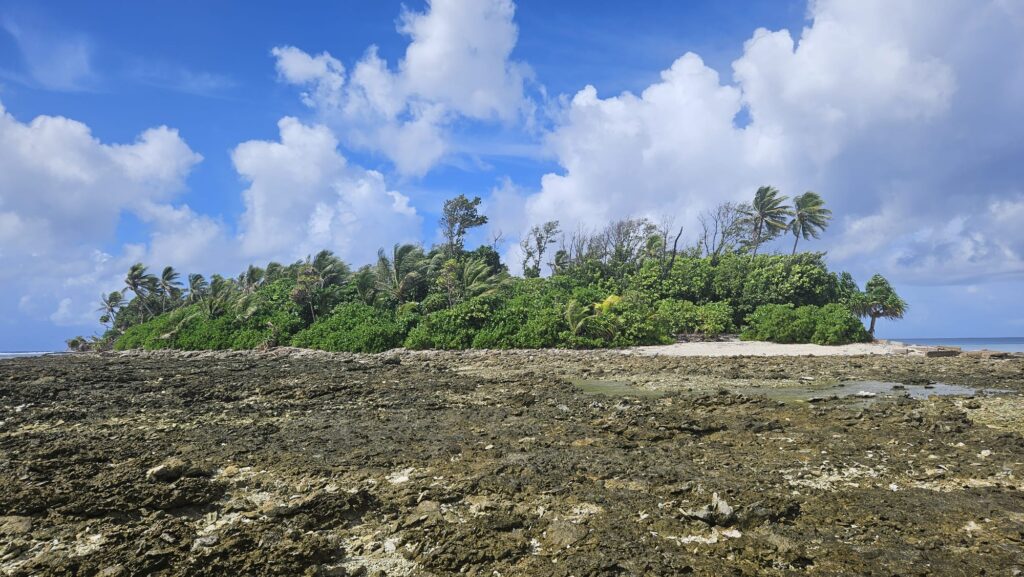
Tuvalu is isolated. Flights limited, imports expensive, infrastructure minimal. Daily life relies on community and resilience. Energy is diesel-dependent. Goods cost more.
Devotion Time 🙏
That night, as darkness fell, we noticed all cars and bikes stopped. The locals explained it was “Devotion Time.”
Every day from 6:45 to 7:00 p.m., everyone pauses. People reflect, pray, or remain still. Even the dogs stopped wandering freely.
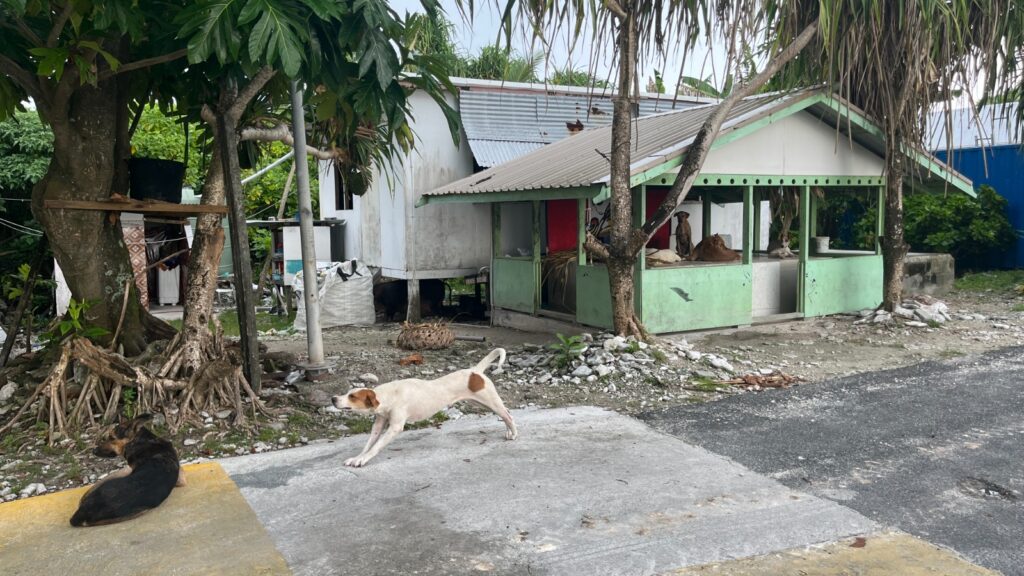
At exactly 7 p.m., life resumed. The streets, bikes, and vehicles moved again. The atmosphere was peaceful, showing how deeply faith shapes daily routines.
Tuvalu Scooter Adventure 🛵
After a tropical storm at night, we rented a scooter. The day was sunny, perfect for exploring.
The scooter ride revealed palm trees, low houses, and scattered debris. Dogs, tombs, and daily life created a chaotic but fascinating tableau.
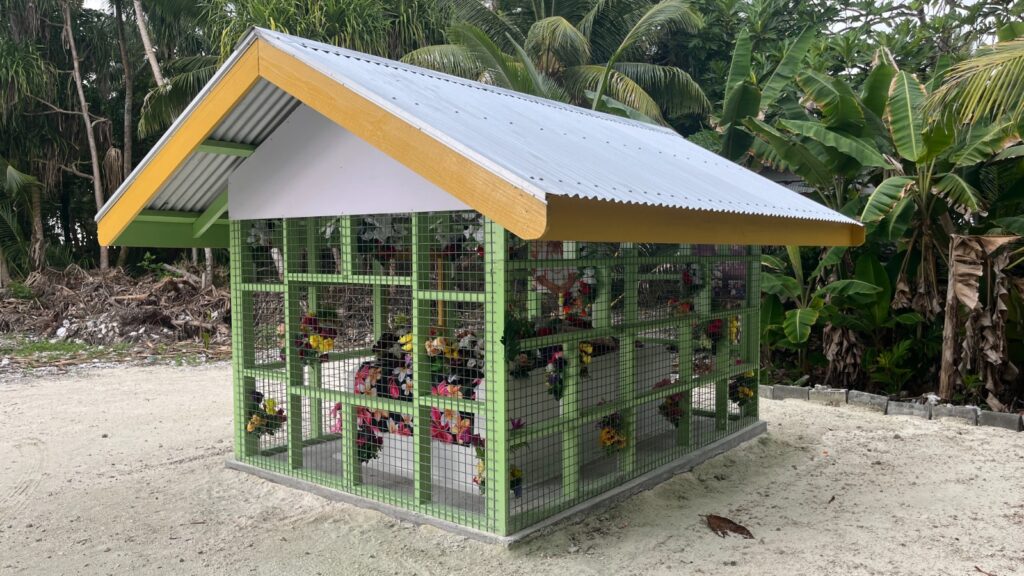
We explored north, passing police preparations, narrow roads, and the harbor. Containers, cargo ships, and functional industrial spaces contrasted with turquoise waters.
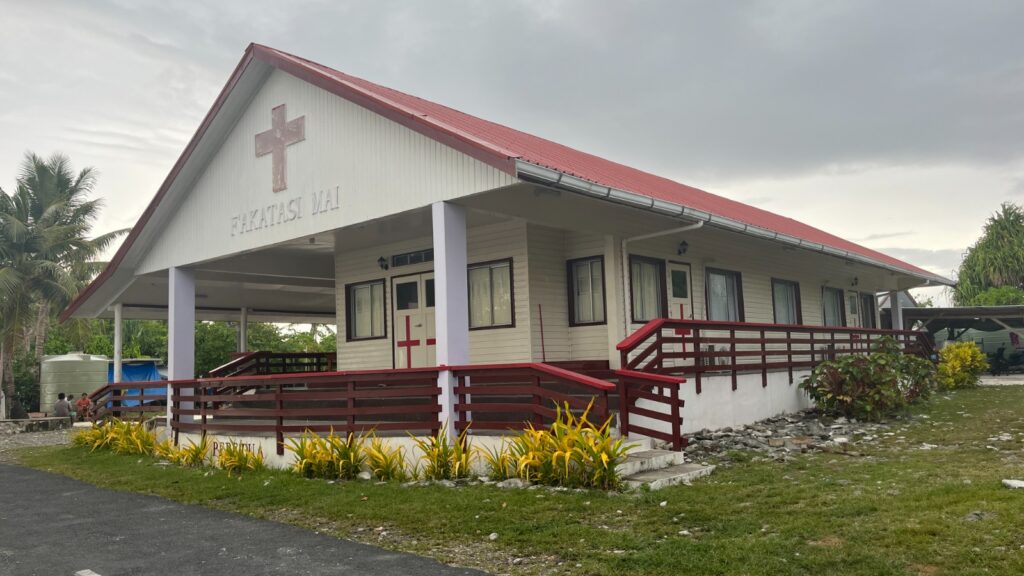
Rubbish remained a constant theme. Toddlers appeared on the roadside, some asking for money, stray dogs tagged along, and we carried an old teddy bear we found.
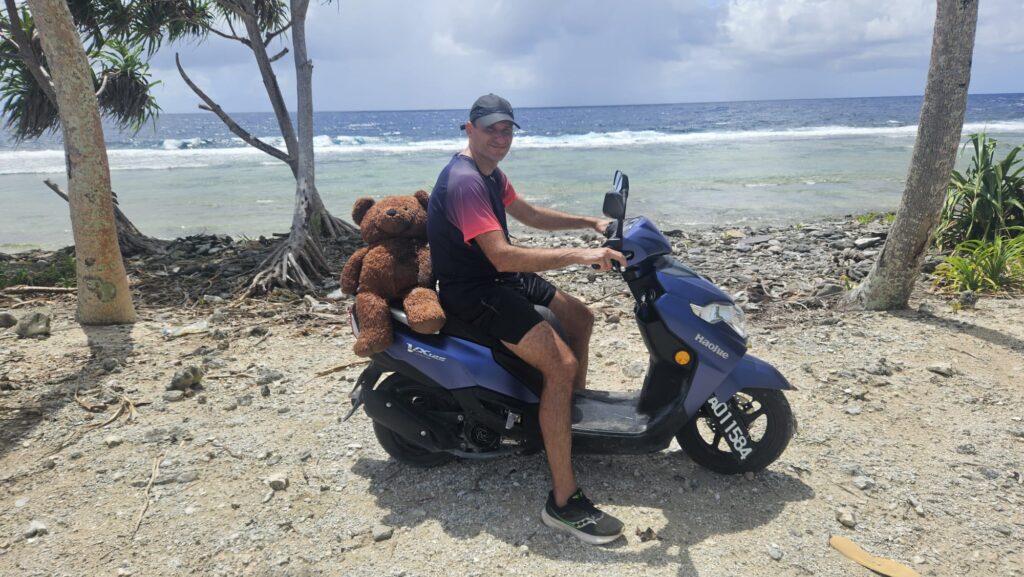
The day’s ride ended with a swim in shallow lagoon waters. Total freedom, solitude, and vivid scenery made it unforgettable. 🌦️
We returned to the hotel for a rest and observed locals relaxing, chatting, and enjoying the evening. The pace of life here is unmatched.
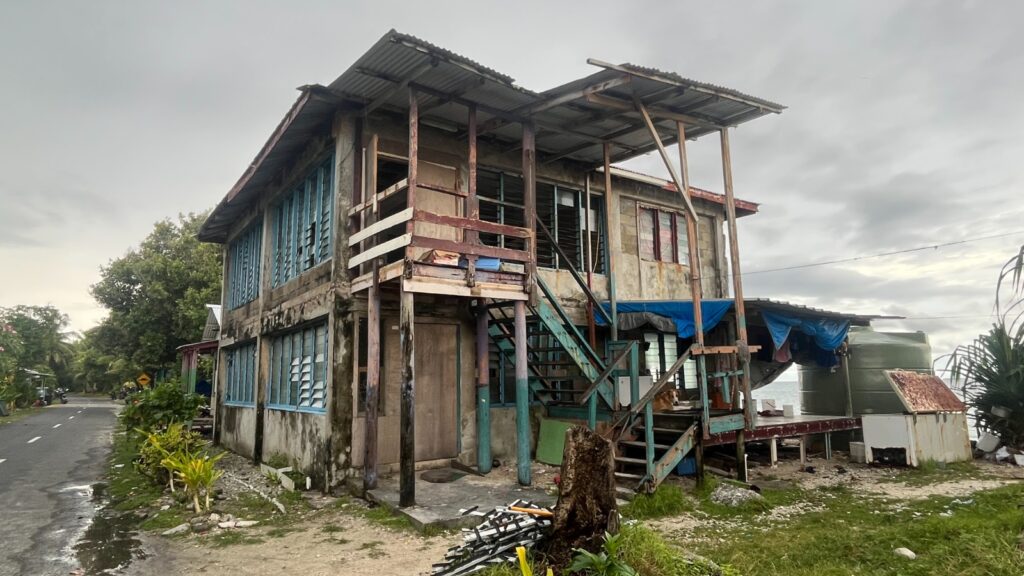
Leaving Tuvalu 🌧️
We were driven to the airport in a new sedan. The driver seemed wealthier than most locals.
Check-in was quick, and we carried our bags. Heavy rain fell before takeoff 😨, then stopped.
The flight back to Suva was uneventful. At Suva, we passed immigration and customs quickly. Boarding the domestic flight to Nadi was smooth. Candies, familiar songs, and a Fijian traveler’s conversation made it cozy.
I now officially consider myself a Fiji Airways expert 😉. The domestic operator is Fiji Link, part of the larger airline.
🏃♀️ The Run 🏃♂️
10k Run in Tuvalu
Some runs are unforgettable. Our first run in Tuvalu was one of them. Weird, exotic, funny, and a little dangerous. Beware of the dogs! 🐕
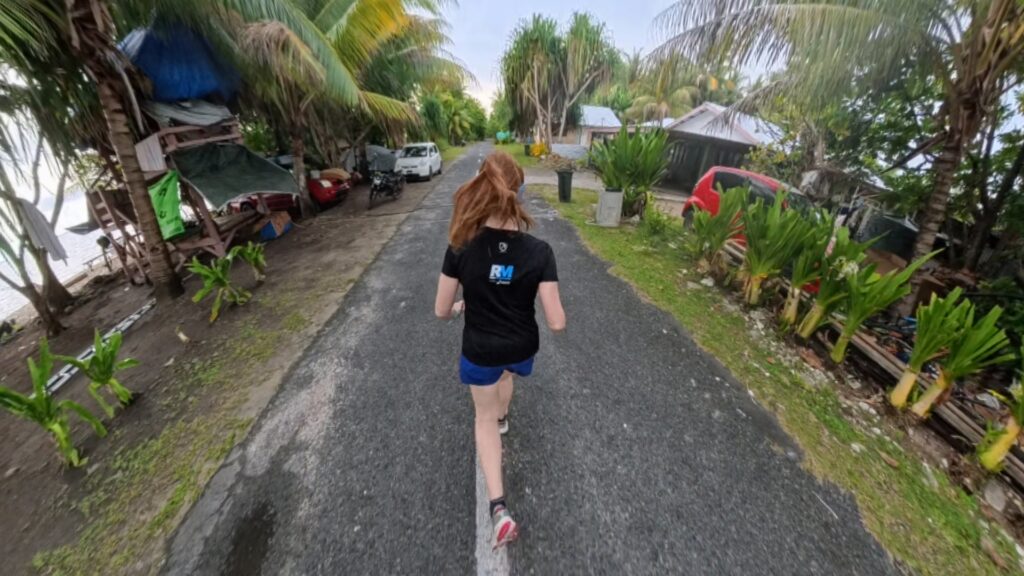
We had just arrived and wanted to explore Fongafale Island. I had studied the geography carefully. Our plan was to run south along the island and back to the airport, maybe 5 kilometers.
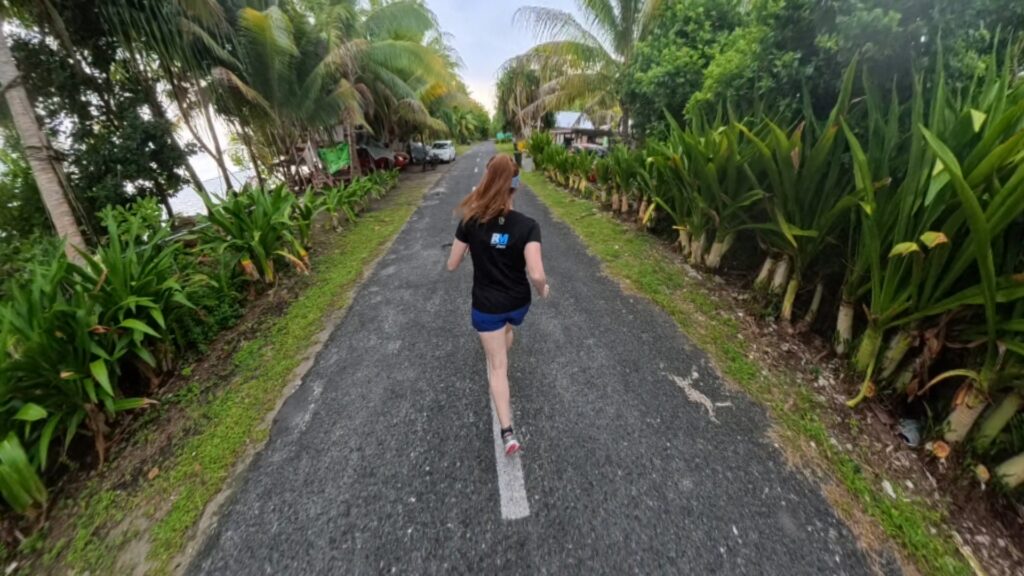
We ended up running 10 kilometers. Along the way, we stumbled upon the Prime Minister of Nauru arriving for a tuna summit. Later, locals carried a massive tuna on a motorbike. It felt like a movie.
The temperature was perfect, despite it being 4 p.m. Clouds threatened, a few drops fell, but no heavy showers. The island’s highest point is just three meters 😄.
Getting to know the island
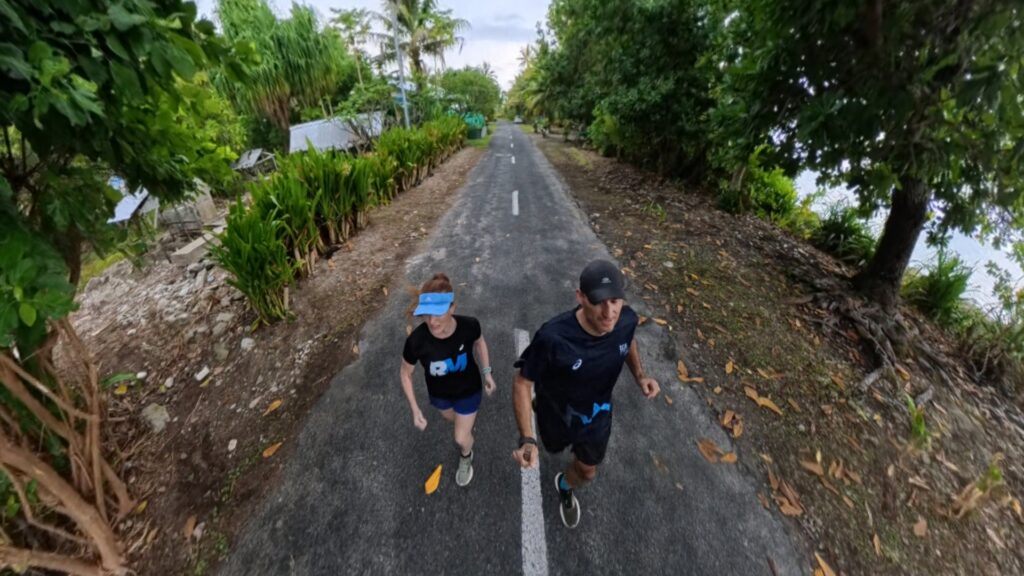
The island had no elevation, no waste bins. It was poor, raw, and functional. Dirt and scattered rubbish everywhere, but it felt authentic. Paradise mixed with reality.
Children played half-naked, waving and shouting “Hello!” endlessly. Some were fully naked, others in nappies. A cheeky one shot us with a water gun.
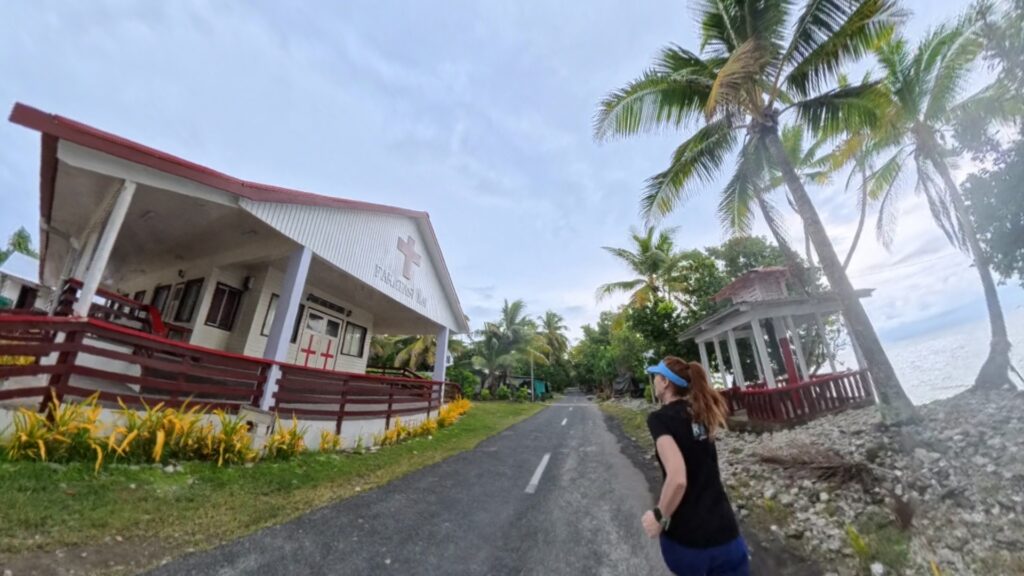
Dogs were the biggest hazard. Most ignored us, but some barked and lunged. I ran in the middle of the street to avoid them. Roger used his insta360 pole to scare them off. Surprisingly effective 😆.
We reached the end of the paved road but continued on an earth trail. A tiny “rainforest” emerged before we hit the southern tip. Rocks flanked the water on each side, leading to a small green island.
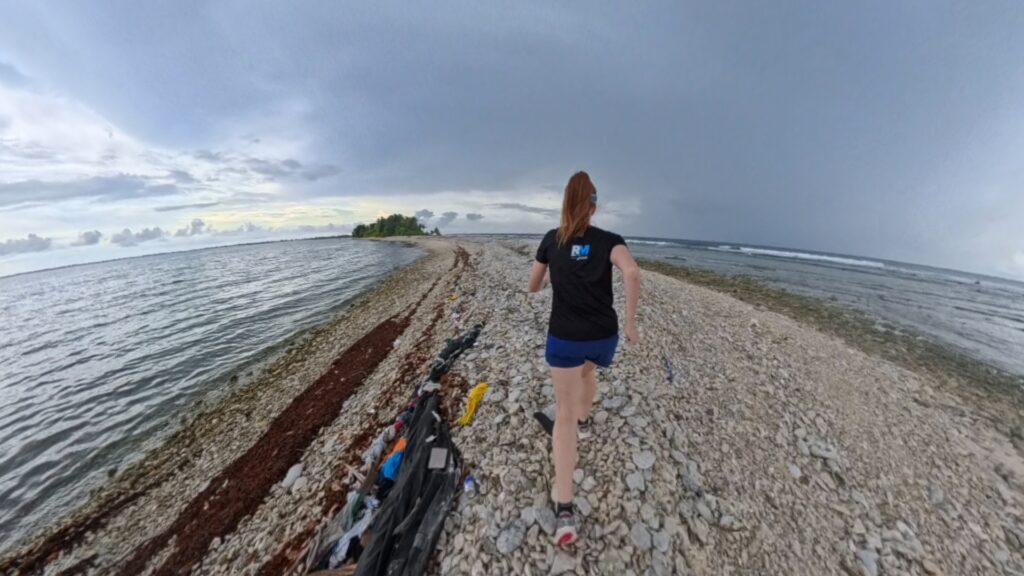
Rubbish spoiled the scenery. We even picked up a fishing hook as a souvenir. Paradise, but messy.
On the way back, we saw what we thought was the only high school bus turning around at the end of the road. Houses were poor, functional, and open to the street. Locals relaxed in hammocks or porches.
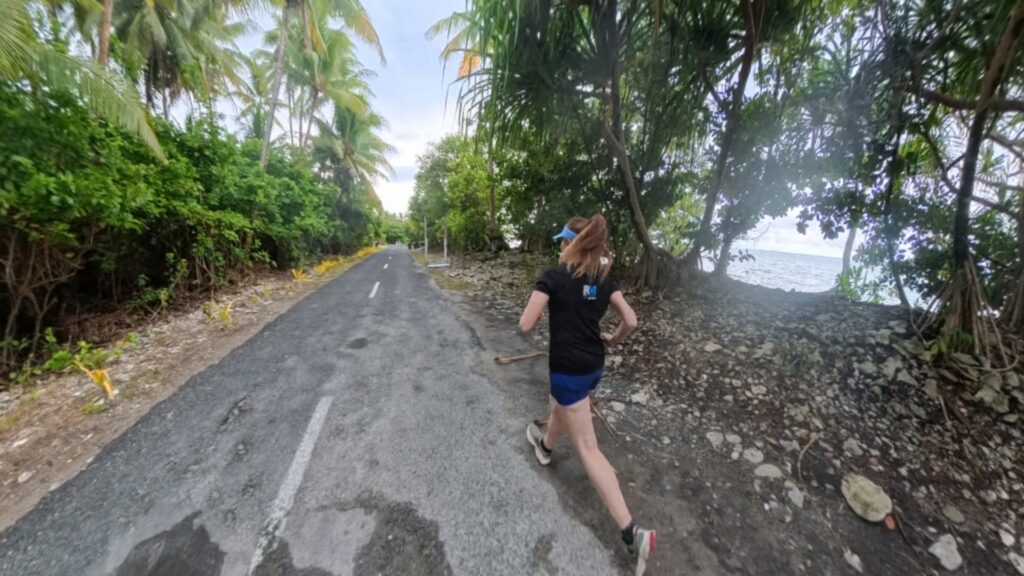
Tombs decorated with flowers and photos were everywhere, sometimes right next to drying clothes. We even saw five dogs napping on a tomb. Nearby, a massive pig roamed freely.
Containers collected rainwater, a vital resource. Rubbish like old washing machines or kitchens sat shamelessly in front of houses. Next to NiuEti Lodge, a tomb of an old man read: “The candle might burn out, but your light persists.”
We continued north toward Funafuti’s “City Centre.” Kids played semi-naked and waved. A “barber-que” restaurant looked dodgy but authentic.
Running on the Runway
We planned to run on the runway, but an alarm blared. A plane was coming. 🛬
Locals gathered to watch. A boy held a foil airplane. Dogs were scared away by an official pickup truck. Then a light appeared in the sky.
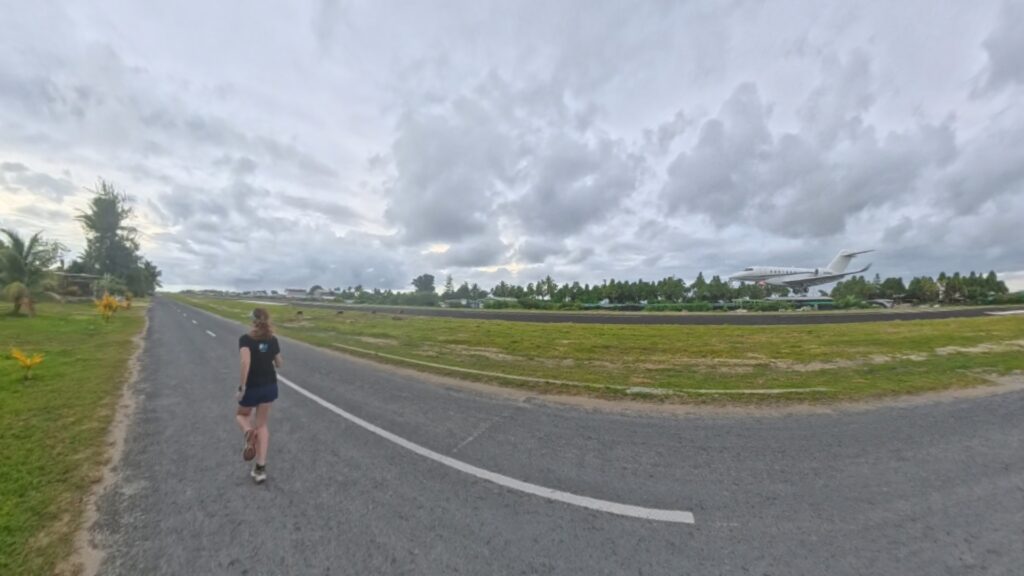
The plane landed at remarkable speed, louder and more spectacular than any video. We ran while it descended. Adrenaline surged!
It was a private jet. People in black suits greeted the passengers. The Tuvalese woman who had helped us earlier confirmed it was the Prime Minister of Nauru. Locals celebrated.
Inside the building, about a hundred people watched a ceremony for the Prime Minister. They danced in flower crowns, straw skirts, and traditional attire. Three elderly women danced at the back. The emotion was palpable.
We were allowed to film but not enter. The PM was here for a “tuna summit.” The Tuvalese woman explained politics: Tuvalu allies with Taiwan, and Australia offers climate asylum to islanders.
The Runway becomes a Playground
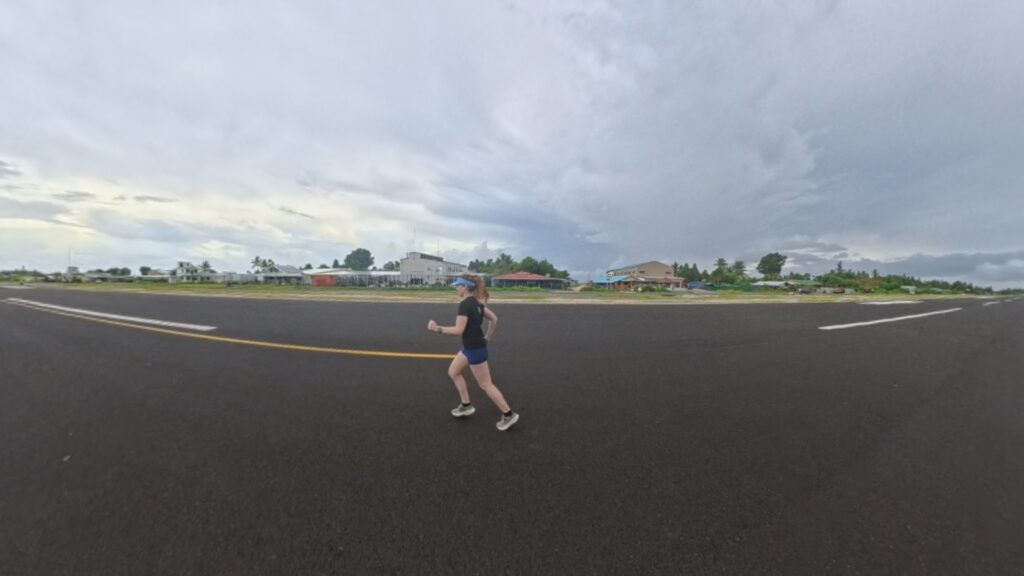
After the jet departed, the locals took over the runway. It became a playground.
Hundreds of kids played rugby, rode bicycles, and cheered. 🏏
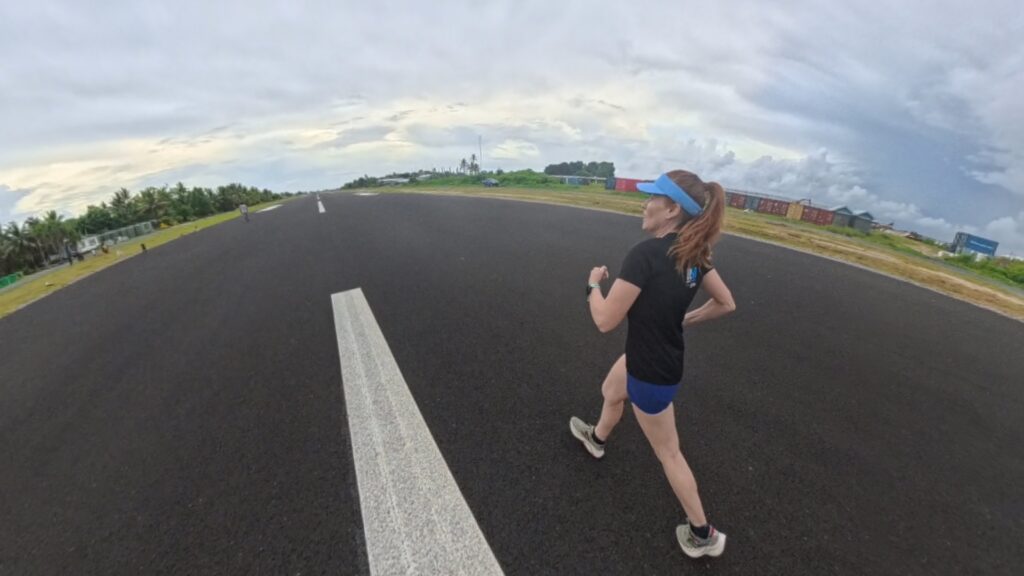
We ran in the middle, where minutes ago a jet had taken off.
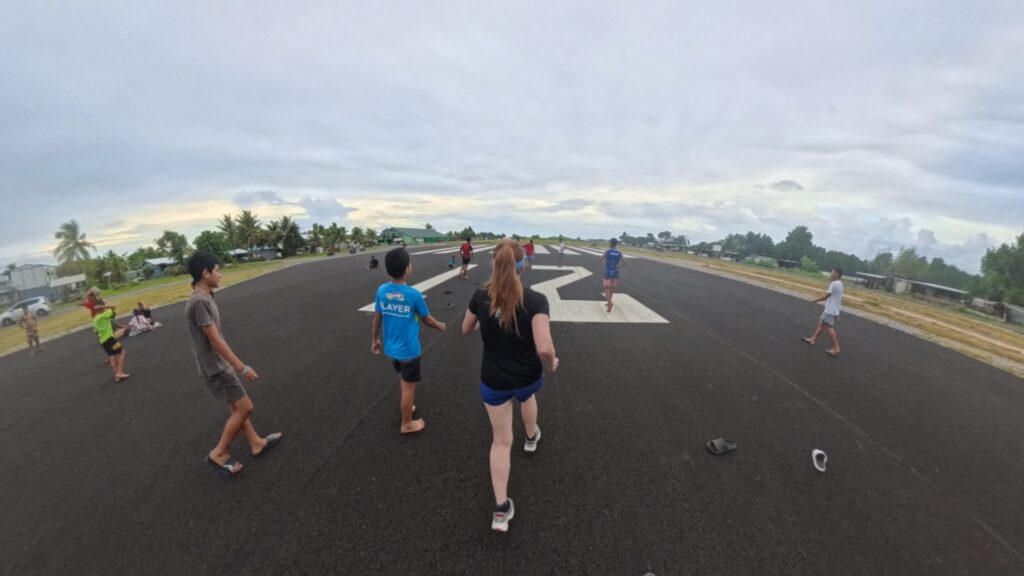
The runway stretched over a kilometer, perfect for running. A large pig even joined the fun.
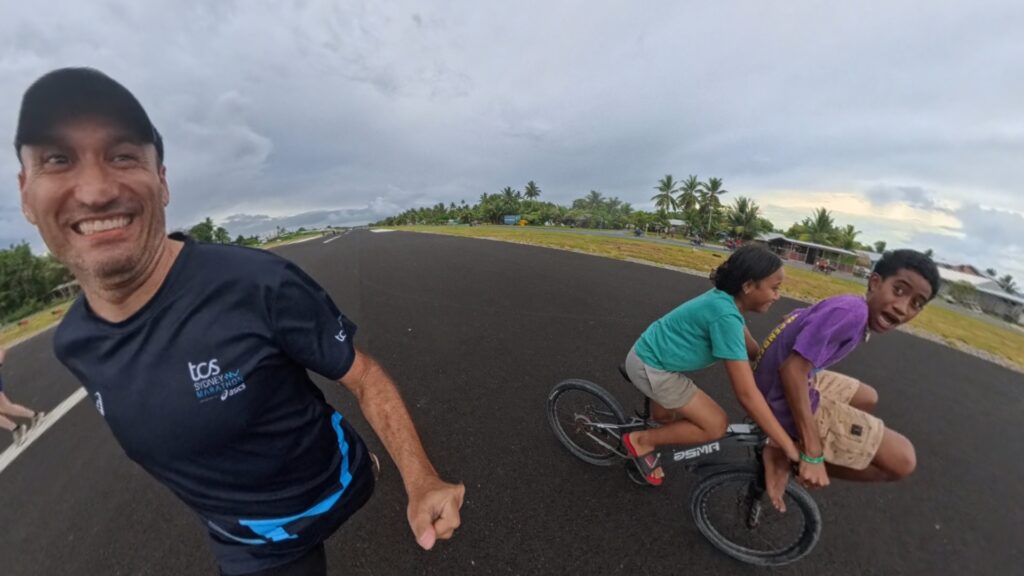
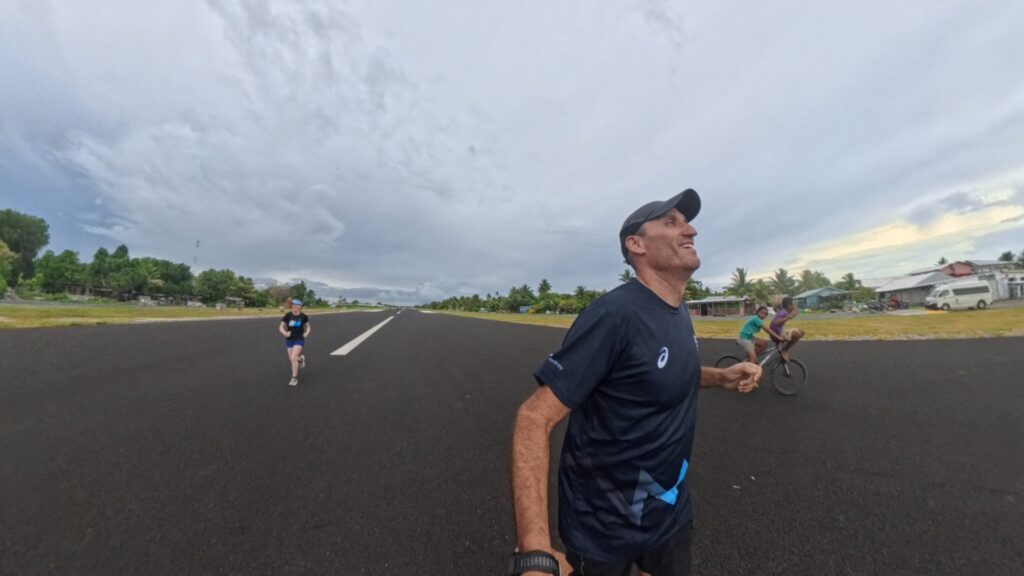
We continued to the rocky coast and the sea. The scenery was wild, remote, and beautiful. Trash littered the rocks, but the isolated views were breathtaking.
On the way back, we stopped at Filomena Hotel and bought two fridge magnets and a t-shirt: “Tuvalu, least visited country.”
A shy puppy with a collar joined us briefly. We reached the rocky beach. Turquoise waters, palm trees, and sunset skies created a magical scene. Kids laughed and played.
NiuEti Lodge Run
We returned to NiuEti Lodge, exhausted but exhilarated. Locals played cards outside while we relaxed. The pace of life here is unmatched.
This run reminded me why Tuvalu is special. The mix of isolation, raw life, and playful chaos is unmatched. The environment is challenging but inspiring.
Running here wasn’t just exercise; it was an immersion. Every step connected us to the land, the people, and the unique rhythms of island life.
The rocks, lagoons, children, dogs, pigs, and ceremonies made it one of the most memorable runs ever. 🌊
Reflections
Running in Tuvalu taught me patience, awareness, and joy in simple experiences. The freedom, solitude, and chaos all coexist beautifully.
The small atolls and reef islands create a unique challenge. Dogs, tombs, and playgrounds demanded creativity. Every corner offered surprises.
This run will stay with me. The combination of humans, animals, and stunning geography made it a one-of-a-kind adventure. Tuvalu isn’t just a destination; it’s an experience.
🍜🍽️ What to Eat before and after running in Tuvalu 🍽️
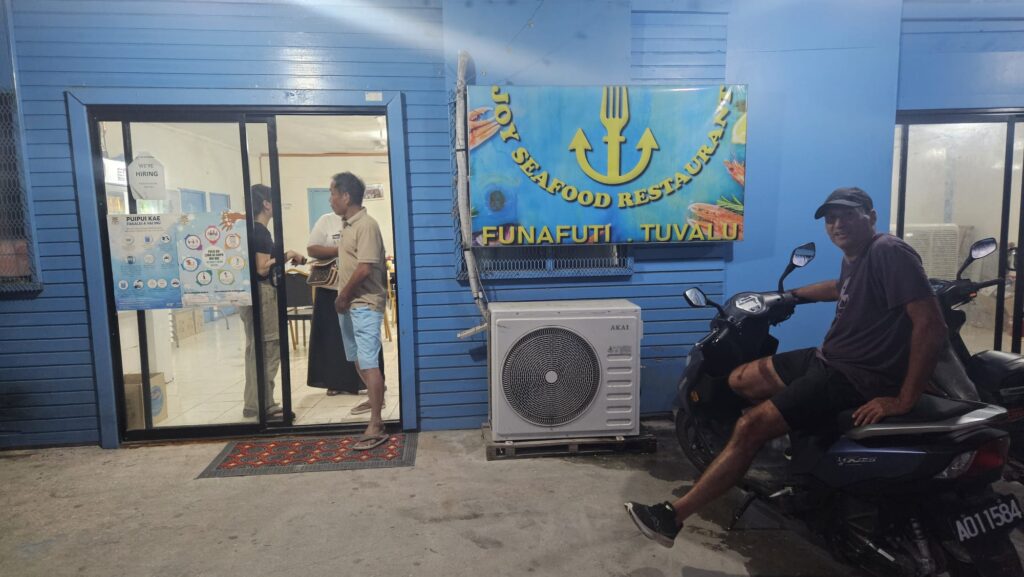
Carboloading (Before the Run)
- Palusami pancakes: Made with taro leaves and coconut cream—sticky, power-packed, like mother nature’s energy bar.
- Breadfruit chips: Crunchy, tropical, and perfect for carb-resets on the go.
- Seasonal papaya: Hydrating and light—nature’s sports drink with vitamin C for glowing skin mid-run.
Fish and chips from any local restaurant (there are several options on the island) can also serve as a carb-rich pre-run meal. 🍴
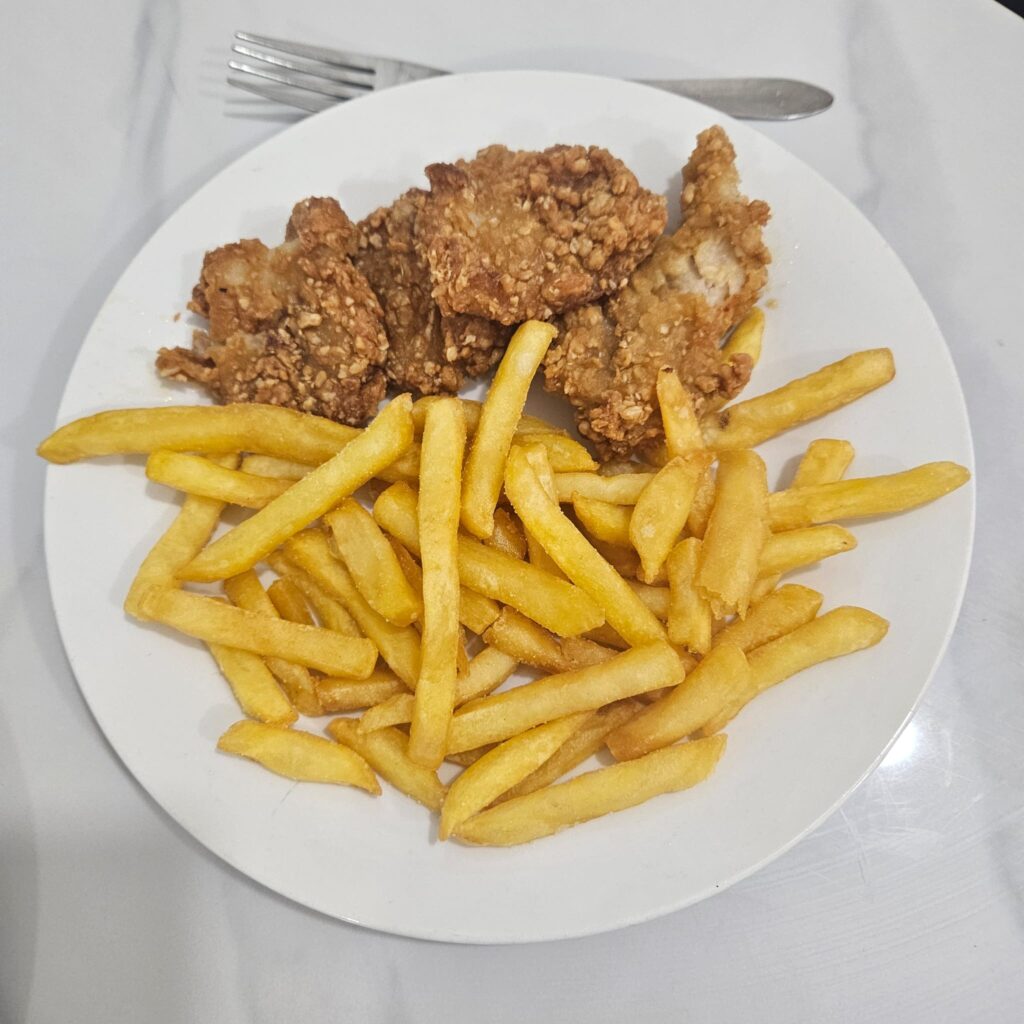
Protein Recovery (After the Run)
- Coconut crab salad: Sweet, savory, and protein-loaded; perfect reward post-run.
- Grilled fish with lime and taro mash: Local reef fish gives you the omega-3s your muscles crave.
- Coconut water + bananas: Simple, sweet, and instantly replenishing—you’ll feel it going into your veins.
Sweet and sour chicken or Beef with Blackbeans, which we tasted in local Chinese restaurant, make a satisfying protein option to restore energy and support muscle repair!
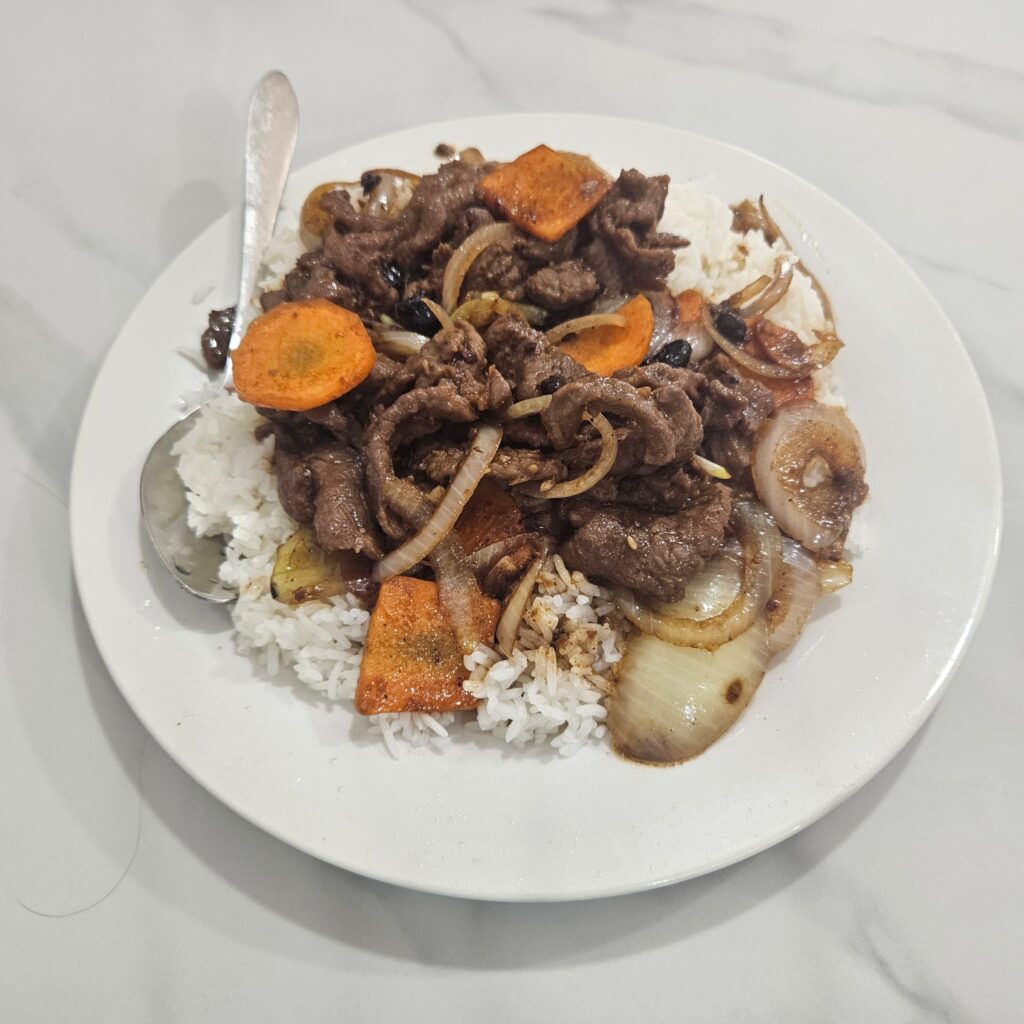


Useful information
🏃 Running in Tuvalu, in Oceania.
👟 Urban: bring shoes for asphalt: although there are areas where you can run on sand or trail, most of the island is one long asphalt road.
✅ Incredible scenery with turquoise waters, narrow atolls, and lush green islands. 🌴
✅ Unique cultural encounters: children cheer, locals wave, and you can run past the Prime Minister’s residence!
⚠️Difficult access: flights are rare, expensive, and often require multiple connections from Fiji. ✈️
⚠️Dogs everywhere: most are calm, but some bark and chase, so stay alert. 🐕

Map
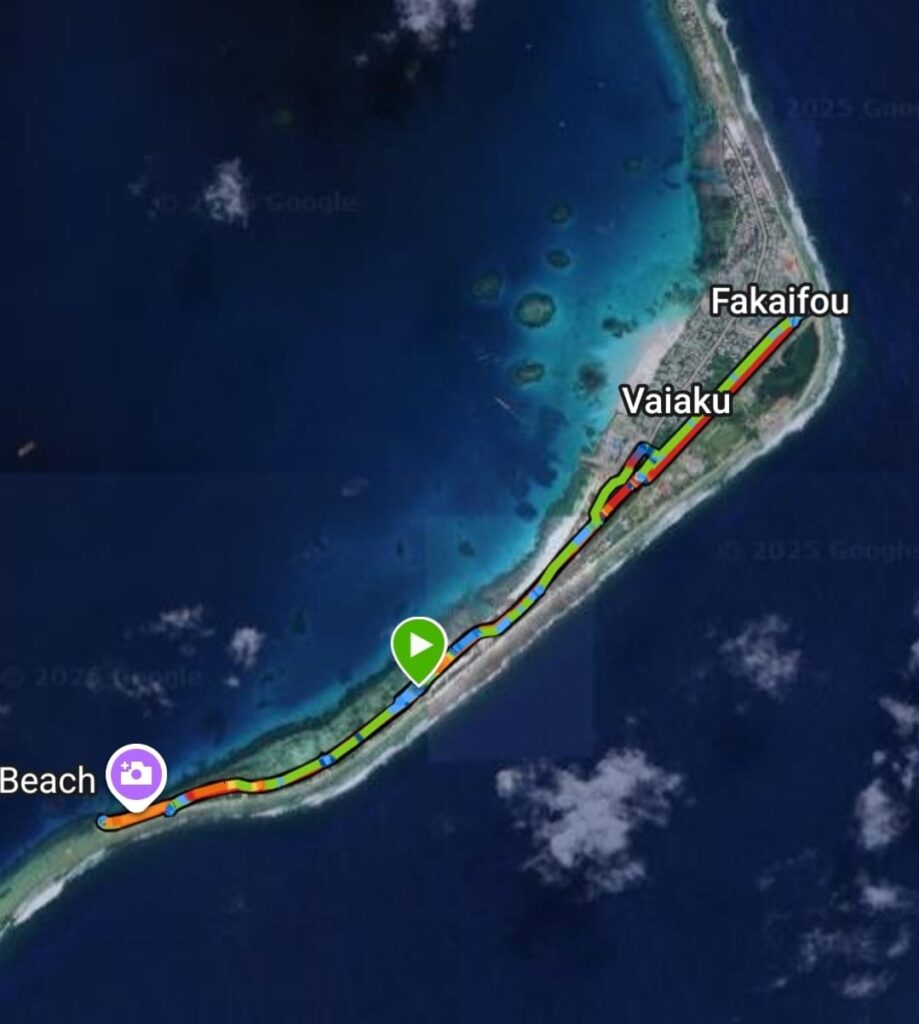
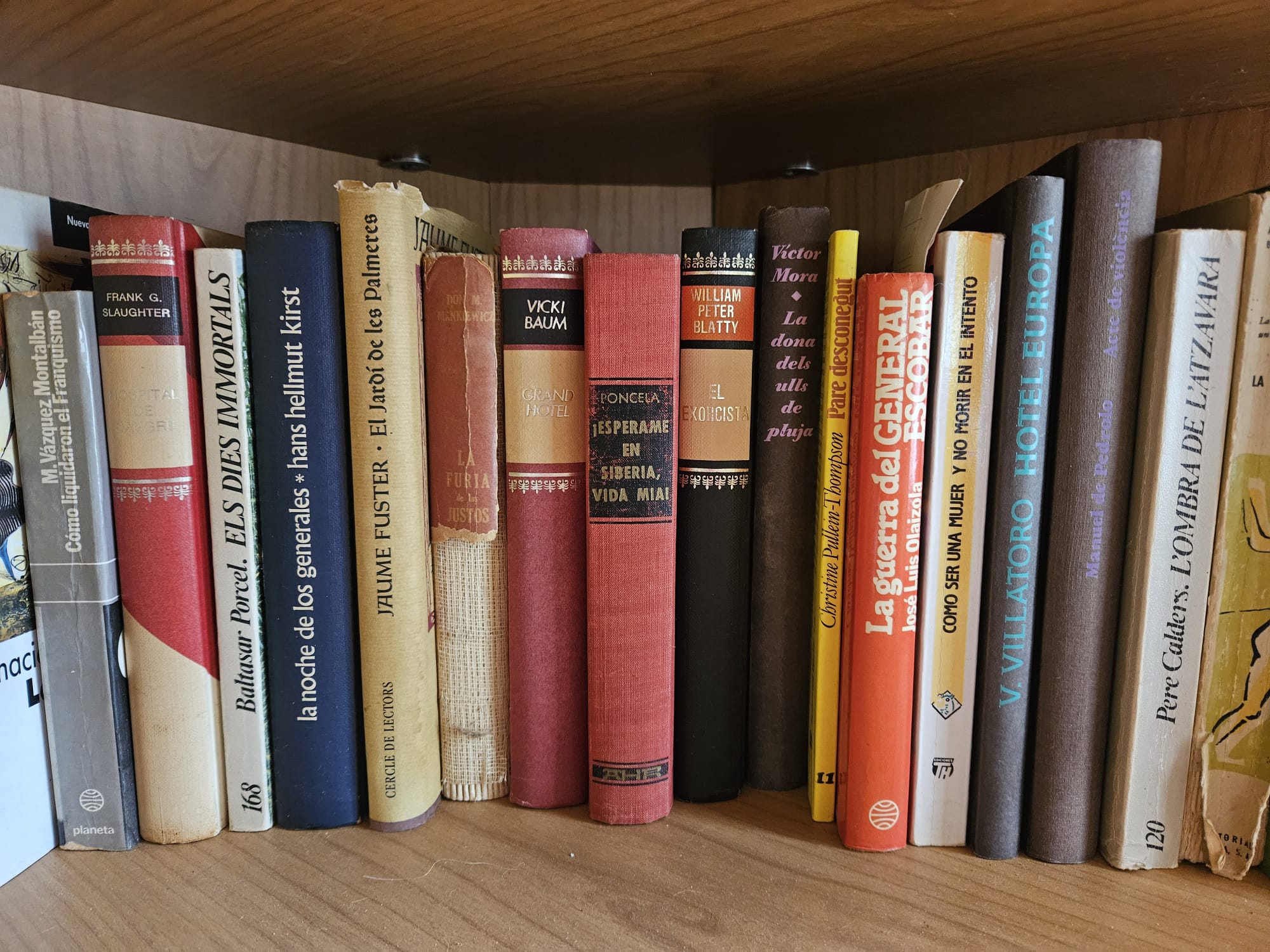
One book
📘 “A Brief History: Tuvalu”
Reading this novel before visiting Samoa is like having a local friend whisper cultural secrets in your ear. You’ll gain genuine insight into fa’a Samoa—from village gossip and church rituals to the weight of cultural expectations and the sweetness of community laughter. The vivid setting prepares you to see beyond the tourist veneer, to embrace the rhythms and stories of daily life in Apia and beyond. It enriches every village visit, beach walk, or casual talanoa with deeper empathy and connection.
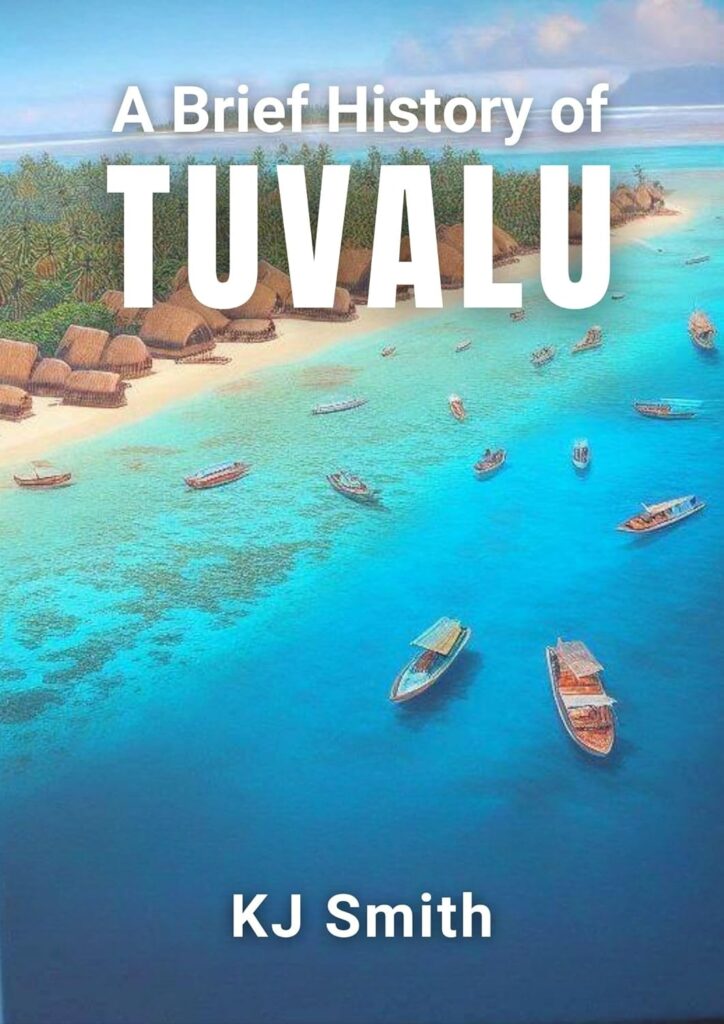
Summary: “A Brief History of Tuvalu” takes readers on a fascinating journey through the history of this small yet resilient Pacific island nation. From its early Polynesian settlers and their rich maritime traditions to the arrival of European explorers in the 16th century, this book provides a concise yet comprehensive look at Tuvalu’s evolution.
Explore the impact of British colonial rule, the effects of World War II on the islands, and the nation’s peaceful transition to independence in 1978. Delve into Tuvalu’s unique cultural heritage, its ongoing fight against climate change due to rising sea levels, and its role on the global stage as a vocal advocate for environmental sustainability. Whether you’re a history enthusiast, a traveler, or simply curious about this remote island nation of stunning atolls and strong traditions, A Brief History of Tuvalu offers an engaging and accessible account of its remarkable past and uncertain future.

To know more…
🎥 & 📚 Other books & movies about Tuvalu worth exploring:
- 📔 “Where the Hell Is Tuvalu?”, by Philip Ells. Non‑fiction memoir. Hilarious and eye-opening tales from a volunteer turned grassroots lawyer in Funafuti—great pre-run vibe inspo.
- 🎬“Time & Tide” (2006). Documentary film. Stunning visuals of island life and climate urgency—ideal to screen before your arrival. (pmagroup.org.nz, goodreads.com, en.wikipedia.org)
- 📔“A Pattern of Islands”, by Arthur Grimble. Memoir. Colonial-era tales shot through with local legend—classic, reflective, and beautifully written.

